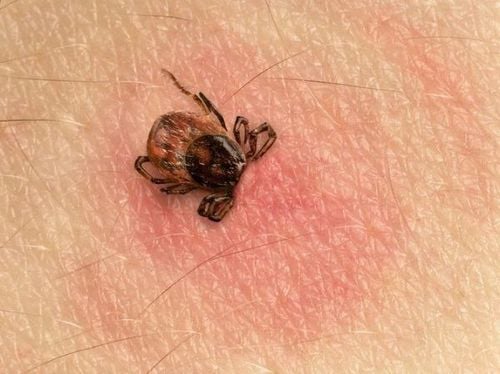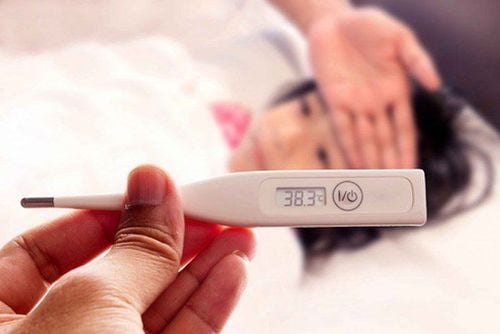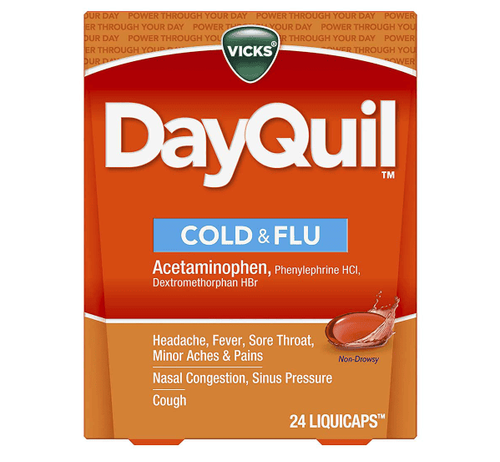This is an automatically translated article.
The article was professionally consulted by Doctor Vo Ha Bang Suong - Doctor of Medicine - Department of Medical Examination & Internal Medicine - Vinmec Phu Quoc International General Hospital. The doctor has more than 15 years of experience in the treatment of internal diseases.Scarlet fever is an infectious disease characterized by prolonged fever, rash, and swollen lymph nodes. The disease is caused by bacteria and requires long-term antibiotic treatment. However, if not detected early, mistaken for other diseases and improperly treated, bacterial toxins will spread, causing organ failure, extremely dangerous.
1. What is tick fever?
Spotted fever, also known as dust fever, is a type of typhus fever caused by Rickettsia. This is a germ that is transmitted from mice to humans through the bite of a larva (Trombicula).The disease is characterized by prolonged fever, on the patient's body there are sores caused by insect stings, papule rash and lymphadenitis. The disease progresses from mild to severe and can be fatal.
Currently, Rickettsial fever still occurs in our country, but the diagnosis is easy to miss due to not paying attention to epidemiological factors, not observing the sores carefully, monitoring the clinical manifestations, so it is easy to mistake it for the disease. other diseases.
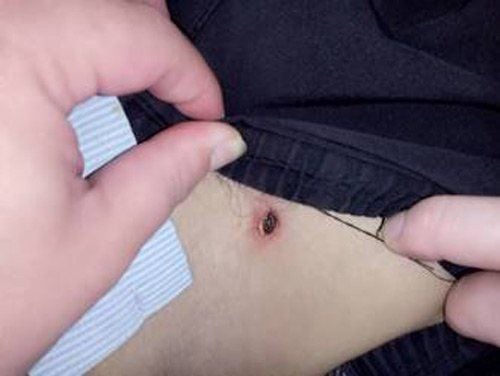
Sốt mò Rickettsia vẫn còn xuất hiện ở nước ta nhưng chẩn đoán rất dễ bị bỏ sót
2. Who is at risk of typhus?
Around the world, this disease is common in tropical Asian countries, especially in mountainous areas with dense trees, moist humus, caves in rocky mountains or places like streams and banks. sea. This place has both hot and humid climate, suitable for squirrels - vectors of disease - to develop, as well as for disease-carrying animals, which are rodents. The appropriate time of year for disease outbreaks is around June to September.Under such conditions, people go to the forest for timber, farming, road work, reclamation, hunting, army units. on the march was stung and infected with bacteria. Even moth larvae also have the opportunity to attack visitors, tourists, explore the mountains, rivers and streams.
Mosquitoes live by sucking blood on the body of warm-blooded animals, especially rodents, represented by mice - the main host of the disease. If you suck on the blood of an animal with Rickettsia, it will also give birth to a generation of infected larvae. Then, if encountering a human body, the worm will cling to it, insert a straw in the mouth into hair follicles or pores in soft, wrinkled skin such as armpits, elbows, knees... and infect bacteria. People.
Ticks are not transmitted from person to person at all.
3. What are the symptoms of typhus?
3.1. clinical
The incubation period of typhus lasts from 6 days to 21 days (median 9 to 12 days). Fever: often sudden onset; Patients with high fever continuously, may be accompanied by chills, headache, body aches. Skin and mucosal manifestations: + Congestive skin, possibly slight edema under the skin of the face and instep; conjunctival congestion+ Skin sores: is a specific sign of typhus; ulcers are oval, 0.5-2 cm in size, with black scales or have scabbed to form ridged, non-exudative ulcers; Ulcers are usually painless, localized to soft areas of skin such as armpits, chest, neck, groin, abdomen, etc.
+ Skin rash: rash usually appears at the end of the first week of illness, has the form of a maculopapular rash. , distributed mainly in the trunk, possibly in the limbs; purpura may occur.
Swollen lymph nodes: patients often have swollen lymph nodes at the ulcer site and lymph nodes in the whole body; The lymph nodes are 1.5-2 cm in size, soft, painless, and normally mobile. Enlarged liver, enlarged spleen: can be seen in about 40% of patients with typhus. In some cases there may be jaundice. Lung damage: patients often have symptoms of cough; auscultation may have rales; some patients showed pleural effusion; Severe cases of fever can have difficulty breathing, acute respiratory failure leading to death. Cardiovascular damage: patients with fever often have low blood pressure; Myocarditis was seen in some cases. Meningitis, encephalitis seen in rare cases. The patient has a headache, there may be a disturbance of consciousness. Without appropriate antibiotic treatment, febrile illness can progress to fatal respiratory and cardiovascular complications. Mild and moderate cases may have a fever that lasts for 3 to 4 weeks, then the fever goes away, but the symptoms of fatigue may persist for a few weeks.
3.2. Subclinical
Blood count: white blood cells normal or increased; the percentage of lymphocytes and monocytes is often increased; Platelets may be low. Chest X-ray: there may be a bronchitis-type lesion; Some patients have pneumonia lesions. Liver function: commonly seen elevation of liver enzymes; possible increase in bilirubin; Many patients have blood protein disorders (low albumin). Renal function: urinalysis may show protein and red blood cells. Renal failure (hyperuremia and creatinine) has been reported in rare cases and is usually reversible with appropriate treatment. Ultrasound: can detect hepatosplenomegaly, pleural effusion, peritoneum. In the case of meningitis, the cerebrospinal fluid may change the meningococcal pattern in clear water, with a slight increase in cells and protein.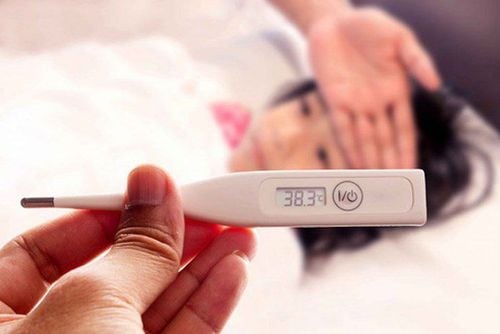
Sốt là triệu chứng sốt mò nổi bật nhất của sốt mò
4. Diagnosis of typhoid fever
4.1 Diagnosis of typhus fever is based on the following factors:
Scarlet fever should be considered when the patient has a history of living in or traveling to areas where typhoid fever is endemic; The patient has an acute febrile illness with damage to many organs and viscera. Clinical diagnosis of typhus is easy if the patient has a specific skin ulcer.Commonly used diagnostic tests for typhus: Serological tests: enzyme-linked immunosorbent antibody (ELISA), indirect immunofluorescence antibody (IFA), indirect immunoglobulin Peroxidase (IIP) detection for IgM.
4.2 Distinguishing typhus from diseases
In the absence of ulcers, diagnosis is difficult because the manifestations of the disease are varied, and are similar to many other acute febrile illnesses such as typhoid fever, leptospirosis, some viral infections, and other rickettsial infections. .Typhoid also presents with fever, hepatosplenomegaly, and damage to many organ systems and viscera. Unlike typhoid fever, typhoid usually has a subacute onset and is accompanied by gastrointestinal symptoms. Erythema in typhoid is usually small in number, distributed mainly in the abdomen and chest. Blood tests often show low white blood cells; cultures of blood, feces and some other specimens growing typhoid bacteria (S.typhi, S.paratyphi of all kinds). Leptospirosis is characterized by fever, muscle aches, possibly rash, jaundice, lung damage, kidney failure; Blood tests may also show thrombocytopenia, elevated liver enzymes. Signs suggestive of a diagnosis of leptospirosis are muscle pain and renal failure. If possible, a serological test can be done to diagnose leptospirosis (eg, Martin - Petit). Arbovirus infections: usually have an acute course with symptoms of fever, headache, body fatigue, possibly a rash..., similar to fever. Hemorrhagic signs associated with thrombocytopenia and elevated hematocrit are more common in dengue hemorrhagic fever. Arbovirus infections are not usually associated with hepatosplenomegaly, rarely have multiple organ and visceral manifestations at the same time, and the disease usually resolves spontaneously within 5-7 days. Other rickettsial infections: The main manifestations of rickettsial infections are similar to those of typhus, including fever, headache, fatigue, rash, and damage to certain organs and organs. Skin-specific ulcers are not seen in tick-borne rickettsial fever (murine typhus), may be seen in typhus rickettsial fever but more rarely in typhus. These diseases often have a more benign course than typhus, have a specific antibody response to the respective antigen, and are also responsive to rickettsial drugs such as doxycycline, chloramphenicol. Sepsis diseases: fever, damage to many organs and viscera as in typhus. Sepsis is rarely accompanied by congestion and skin rash, effusion of membranes. It is necessary to carefully examine the skin and detect specific ulcers so as not to miss typhus; Do a blood culture test to identify the bacteria causing the infection
5. Treatment and prevention
Treatment of typhus is antibiotic-based. Doxycycline and Chloramphenicol are the two commonly used antibiotics. The drug can be given by injection or orally, for 7 to 15 days.Besides, the treatment should pay attention to support the nutritional status of the patient when eating less, malabsorption; correcting water-electrolyte disorders due to prolonged high fever, digestive disorders.
6. Progression and complications
Patients with typhus are treated with specific antibiotics, usually without fever within 1 to 3 days; The symptoms of rash, lymphadenopathy, hepatosplenomegaly... also gradually receded along with the decrease in temperature and after the fever was cut off. Pleural effusion and changes in cerebrospinal fluid canTo prevent fever, it is necessary to actively clear the area around the house, clean up weeds, overgrown trees as well as kill rats and rodents . When going to the forest to visit or work, pay attention to avoid resting under dense vegetation, many weeds and humus; Do not lie on the ground but should lie on a high hammock. Should wear modest clothes, high-heeled shoes. Insect repellent should be applied to open skin spaces.
In summary, typhus is not a common disease in a densely populated community. However, in the summer, when it's rainy and hot, families and teenagers often choose to have fun, explore nature and jungle, which is difficult to avoid the risk of exposure to pathogens. Therefore, each person needs to be equipped with knowledge about this disease to have an effective way to prevent and recognize the disease.
Please dial HOTLINE for more information or register for an appointment HERE. Download MyVinmec app to make appointments faster and to manage your bookings easily.





